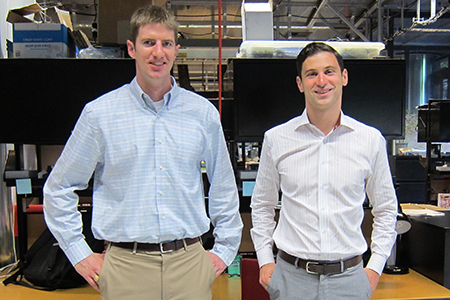Stories
Reducing Costs and Improving Care—Stanford Biodesign Fellows Take The Pain Out of ICU Intubation

Rush Bartlett and Ryan Van Wert, Stanford Biodesign Innovation Fellows from 2012-13, are helping take costs out of the healthcare system while improving patient care.
With national healthcare expenditures estimated at 18 percent of GDP, the United States can no longer afford to adopt innovative health technologies that improve patient care at any cost. A new era of healthcare innovation is required, with novel technologies developed explicitly to reduce costs while sustaining or improving clinical outcomes. Stanford Biodesign is seeking to address this challenge, in the US and around the world, by training its post-graduate Biodesign Innovation Fellows how to integrate a value-orientation in everything they do. This starts by identifying unmet healthcare needs with the potential for value improvement and then inventing solutions with a cost/benefit ratio that patients, providers, and payers will find compelling enough to change existing care paradigms.
Two Stanford Biodesign Innovation Fellows, Rush Bartlett II, who holds a PhD in biomedical engineering and an MBA, and Ryan Van Wert, a physician in pulmonary and critical care medicine, sought to tackle this challenge when completing the program in 2012-13. They identified a need to reduce or eliminate the use of intravenous (IV) sedation in patients that have breathing tubes in the intensive care unit (ICU). Because intubation is so painful—“like having a snorkel shoved down your throat,” describes Bartlett—powerful narcotics are routinely used to keep these patients heavily sedated. However, not only are the drugs expensive, costing up to $800 per day, they are routinely linked to debilitating complications, including ventilator-associated pneumonia, pressure ulcers, and muscle weakness that can add as much as six months of rehabilitation to a patient’s recovery. More than half of heavily sedated ICU patients also develop delirium, a devastating condition that costs up to $30 billion annually to treat in the US.
To truly understand the need, Bartlett and Van Wert researched the clinical literature, immersed themselves in the ICU to observe intubation and sedation practices, and spoke with an array of intensive care providers, including doctors, nurses, and respiratory therapists. Their key insights, however, came when they began to investigate similar procedures across treatment areas. In particular, they were struck by the use of a local anesthetic to numb a patients’ throats before bronchoscopy, in which a tube is inserted into the throat for diagnostic purposes. They were also intrigued by the fact that equally sick patients in the ICU with a tracheostomy, in which the breathing tube in inserted through an opening at the base of the throat, did not require sedation at all because the tube does not trigger the gag reflex.
“We realized that the placement of the tube in the upper airway was the primary source of discomfort, and that, in another clinical circumstance, the application of local anesthetic was effective on a short term basis,” says Van Wert. Ultimately, after investigating numerous solutions, Bartlett and Van Wert developed the Wyshbone catheter, a drug-delivery catheter that provides a measured, long term, continuous topical application of anesthetic to the upper airway, minimizing or even eliminating the need for IV sedation in intubated ICU patients.
While the Wyshbone catheter vastly improves care and comfort for patients, it also has substantial benefits for payers and providers. In the long term, non-sedated patients recover faster, have a lower risk of delirium, and are less likely to suffer muscle atrophy. “Anything that helps elderly patients get better and get out of the ICU or regular ward faster is something that hospital administrators love,” says Bartlett.
The Wyshbone product also provides near-term value by reducing costs linked to IV sedation. “The bottom line is that, over a short period of time, we could prove that we could reduce the amount of sedation by a certain percentage. And that corresponds to a dollar value reduction in sedation costs. This allowed us to focus on value we could capture without having to prove the downstream clinical reductions and outcomes until we could start to do larger clinical studies,” Bartlett explains.
Describing the promise of Wyshbone, Stephen Ruoss, professor of pulmonary and critical care medicine at the Stanford University Medical Center, summarizes, “The cost of ICU care creates a tremendous burden for hospitals, insurance companies, and patients alike. Wyshbone represents a simple change in practice that has the potential to improve the patient experience while dramatically reducing costs and complications.”
The company that Bartlett and Van Wert founded to develop their product, AWAIR Inc., was acquired by Cook Medical in 2015. The innovators look forward to seeing the technology adopted into clinical practices in the near future, where it will generate value for both patients and health systems.
